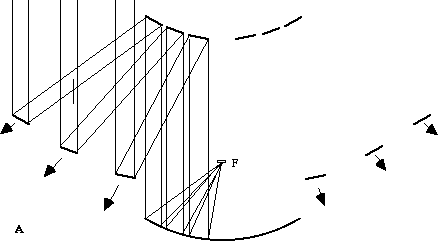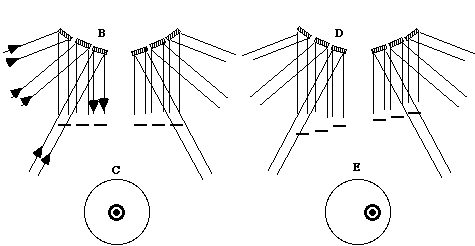



Figure 2: Basic scheme of a Densified-Pupil Imaging Interferometer, here shown for clarity with flat collecting mirrors rather than telescopes (A). Collimated beams received from several flat mirrors (or from afocal telescopes) on flat mirrors Mi become parallel. The entrance aperture can be made thousands of times larger than the sub-apertures by translating (arrows) the collecting optics to enlarge their paraboloidal locus. The size ratio of sub-apertures and the aperture is considerably increased in the exit pupil, where the sub-apertures can be nearly adjacent. With a point source on axis (B), the wavefront segments (fat lines) can be phased to reconstruct a flat wave. The resulting image (C) has a peaked interference pattern (fat peak and ring), multiplied by a wider "window" (within the thin ring), the diffraction function which is the Airy pattern of the sub-apertures. An off-axis point source provides wave-front segments (D)which are slightly tilted, but the comparatively large optical path differences occurring in the interferometer arms cause a much stronger global tilt of the reconstructed wave. T thus obtained has a much steeper average slope than a single stair. In the image (E), the stair-shaped reconstructed wave generates a slightly displaced diffraction function, and a more markedly displaced interference function. Assuming many point sources or an extended source, the classical convolution holds for the interference function, but the diffraction function causes a field limitation. The number of resolved elements is limited to N2 with N apertures, in accordance with the general rule stated by Lannes [25] for snapshot imaging.